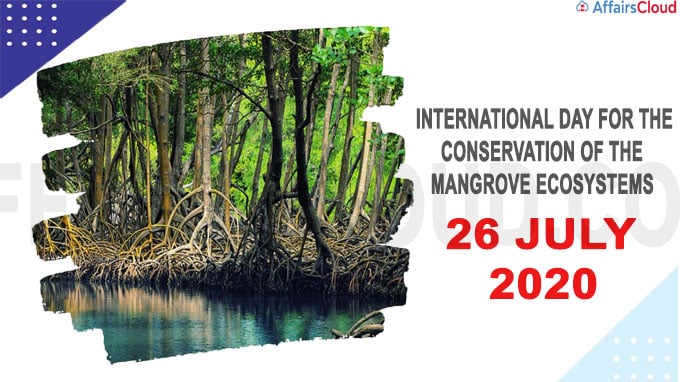
The International Day for the Conservation of the Mangrove Ecosystem is observed annually
in July .
The mangrove ecosystem is a unique and valuable coastal ecosystem found in
tropical and subtropical regions around the world. It consists of dense, salt-tolerant
trees and shrubs known as mangroves, which grow in intertidal zones, where the
land meets the sea. These ecosystems play a crucial role in supporting biodiversity,
protecting coastlines, and providing various ecosystem services.
Characteristics of the Mangrove Ecosystem:
1. Mangrove Trees: The dominant vegetation in this ecosystem is the mangrove
trees, which are specially adapted to the challenging conditions of high
salinity, tidal fluctuations, and waterlogged soils. Some common mangrove
tree species include the red mangrove (Rhizophora spp.), black mangrove
(Avicennia spp.), and white mangrove (Laguncularia racemosa).
2. Intertidal Zone: Mangroves grow in the transition zone between land and sea,
known as the intertidal zone. This zone is submerged during high tide and
exposed during low tide.
3. Root Systems: Mangroves have unique root systems that help them cope with
the harsh environment. They often have stilt-like roots called
"pneumatophores" that protrude from the soil, allowing the trees to obtain
oxygen even when submerged in water.
4. Biodiversity: Mangroves support a diverse array of plant and animal species.
They serve as nurseries and breeding grounds for various marine organisms,
including fish, crustaceans, and birds.
5. Coastal Protection: The dense root systems of mangroves act as a natural
buffer against coastal erosion, storm surges, and tsunamis. They help
stabilize shorelines and protect nearby communities and infrastructure from
the impact of extreme weather events.
6. Nutrient Cycling: Mangrove ecosystems are essential for nutrient cycling and
water purification. They filter pollutants and excess nutrients from the water,
helping to maintain water quality in coastal areas.
7. Carbon Sequestration: Mangroves are highly efficient carbon sequesters.
They capture and store large amounts of carbon dioxide from the atmosphere,
playing a vital role in mitigating climate change.
Threats to Mangrove Ecosystems:
Despite their importance, mangrove ecosystems are facing significant threats,
primarily due to human activities. Some of the major threats include:
1. Coastal Development: Rapid urbanisation and industrialization often lead to
the destruction of mangrove habitats for infrastructure development and
aquaculture.
2. Deforestation: Illegal logging and clearing of mangrove forests for timber and
charcoal production can devastate these fragile ecosystems.
3. Pollution: Discharge of pollutants, including oil spills and chemical waste, can
harm mangroves and the organisms that rely on them.
4. Climate Change: Rising sea levels and changes in weather patterns due to
climate change can disrupt mangrove habitats and lead to their degradation.
5. Overfishing: Excessive fishing and unsustainable harvesting of marine
resources within mangrove areas can disrupt the delicate ecological balance.
Conservation and Importance:
Efforts are underway worldwide to conserve and protect mangrove ecosystems due
to their critical ecological and socio-economic significance. Conservation strategies
include establishing protected areas, promoting sustainable resource management
practices, and raising awareness about the importance of mangroves.Preserving
mangrove ecosystems is vital for safeguarding coastal biodiversity, maintaining
fisheries, reducing the impacts of climate change, and ensuring the well-being of
coastal communities.
∎